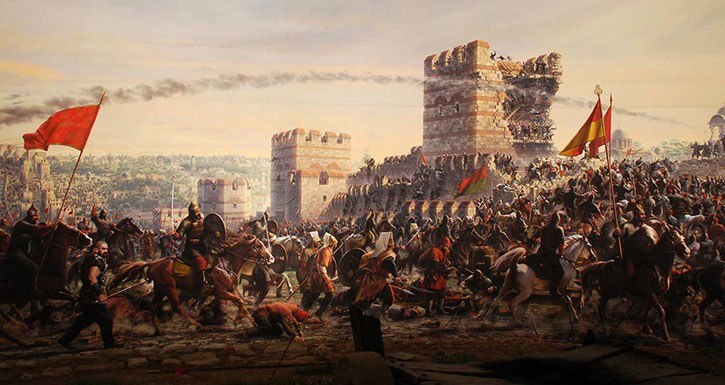The fall of Constantinople, also known as the conquest of Constantinople, was the capture of the capital of the Byzantine Empire by the Ottoman Empire. The city was captured on 29 May 1453 as part of the culmination of a 55-day siege which had begun on 6 April. The attacking Ottoman Army, which significantly outnumbered Constantinople's defenders, was commanded by the 21-year-old Sultan Mehmed II (later nicknamed "the Conqueror"), while the Byzantine army was led by Emperor Constantine XI Palaiologos. After conquering the city, Mehmed II made Constantinople the new Ottoman capital, replacing Adrianople. The fall of Constantinople and of the Byzantine Empire was a watershed of the Late Middle Ages, marking the effective end of the Roman Empire, a state which began in roughly 27 BC and had lasted nearly 1500 years. For many modern historians, the fall of Constantinople marks the end of the medieval period and the beginning of the early modern period. The city's fall also stood as a turning point in military history. Since ancient times, cities and castles had depended upon ramparts and walls to repel invaders. The Walls of Constantinople, especially the Theodosian Walls, protected Constantinople from attack for 800 years and were noted as some of the most advanced defensive systems in the world at the time. However, these fortifications were overcome with the use of gunpowder, specifically from Ottoman cannons and bombards, heralding a change in siege warfare.[23] The Ottoman cannons repeatedly fired massive cannonballs weighing 500 kilograms (1,100 lb) over 1.5 kilometres (0.93 mi) which created gaps in the Theodosian Walls for the Ottoman siege.

1. The Byzantine Empire
Constantinople had been an imperial capital since its consecration in 330 under Roman emperor Constantine the Great. In the following eleven centuries, the city had been besieged many times but was captured only once before: the Sack of Constantinople during the Fourth Crusade in 1204.The crusaders established an unstable Latin state in and around Constantinople while the remainder of the Byzantine Empire splintered into a number of successor states, notably Nicaea, Epirus and Trebizond. They fought as allies against the Latin establishments, but also fought among themselves for the Byzantine throne.The Nicaeans eventually reconquered Constantinople from the Latins in 1261, reestablishing the Byzantine Empire under the Palaiologos dynasty. Thereafter, there was little peace for the much-weakened empire as it fended off successive attacks by the Latins, Serbs, Bulgarians and Ottoman Turks. Between 1346 and 1349, the Black Death killed almost half of the inhabitants of Constantinople.[31] The city was further depopulated by the general economic and territorial decline of the empire, and by 1453, it consisted of a series of walled villages separated by vast fields encircled by the fifth-century Theodosian Walls.
2. Preparations
When Mehmed II succeeded his father in 1451, he was 19 years old. Many European courts assumed that the young Ottoman ruler would not seriously challenge Christian hegemony in the Balkans and the Aegean.[32] In fact, Europe celebrated Mehmed coming to the throne and hoped his inexperience would lead the Ottomans astray.[33] This calculation was boosted by Mehmed's friendly overtures to the European envoys at his new court.[34] But Mehmed's mild words were not matched by his actions. By early 1452, work began on the construction of a second fortress (Rumeli hisarı) on the European side of the Bosphorus,[35] several miles north of Constantinople. The new fortress sat directly across the strait from the Anadolu Hisarı fortress, built by Mehmed's great-grandfather Bayezid I. This pair of fortresses ensured complete control of sea traffic on the Bosphorus[34] and defended against attack by the Genoese colonies on the Black Sea coast to the north. In fact, the new fortress was called Boğazkesen, which means "strait-blocker" or "throat-cutter". The wordplay emphasizes its strategic position: in Turkish boğaz means both "strait" and "throat". In October 1452, Mehmed ordered Turakhan Beg to station a large garrison force in the Peloponnese to block Thomas and Demetrios (despotes in Southern Greece) from providing aid to their brother Constantine XI Palaiologos during the impending siege of Constantinople. Karaca Pasha, the beylerbeyi of Rumelia, sent men to prepare the roads from Adrianople to Constantinople so that bridges could cope with the massive cannons. Fifty carpenters and 200 artisans also strengthened the roads where necessary. The Greek historian Michael Critobulus quotes Mehmed II's speech to his soldiers before the siege.
3. European support
Byzantine Emperor Constantine XI swiftly understood Mehmed's true intentions and turned to Western Europe for help; but now the price of centuries of war and enmity between the eastern and western churches had to be paid. Since the mutual excommunications of 1054, the Pope in Rome was committed to establishing unity with the eastern church. The union was agreed by the Byzantine Emperor Michael VIII Palaiologos in 1274, at the Second Council of Lyon, and indeed, some Palaiologoi emperors had since been received into the Latin Church. Emperor John VIII Palaiologos had also recently negotiated union with Pope Eugene IV, with the Council of Florence of 1439 proclaiming a Bull of Union. The imperial efforts to impose union were met with strong resistance in Constantinople. A propaganda initiative was stimulated by anti-unionist Orthodox partisans in Constantinople; the population, as well as the laity and leadership of the Byzantine Church, became bitterly divided. Latent ethnic hatred between Greeks and Italians, stemming from the events of the Massacre of the Latins in 1182 by the Greeks and the Sack of Constantinople in 1204 by the Latins, played a significant role. Ultimately, the attempted union between east and west failed, greatly annoying Pope Nicholas V and the hierarchy of the Roman church.
For More Information Click Given Button